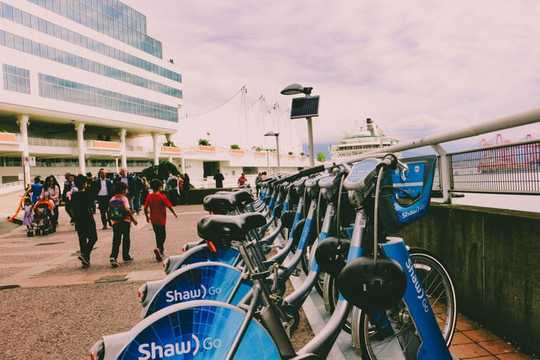
As bike sharing and other forms of micromobility become more common in global transportation systems, who benefits? Ben Mater/unsplash
Bike and scooter sharing is booming in cities all around the world. In the United States, the number of trips through either bike or scooter sharing — modes of transportation called “micromobility” — more than doubled over one year, from 35 million trips in 2017 to 84 million in 2018.
As micromobility becomes more commonplace in global transportation systems, it’s important to ask “Who benefits?”
Researchers have scrutinized both the location of bike-share programs and who actually uses them. Several studies have found that these programs are typically located in wealthier, more well-off neighbourhoods.
A 2019 report on Citi Bike in New York City found that the bike-share program reached every high-income neighbourhood (areas populated by people with greater than $200,000 median income) but only three in 10 low-income neighbourhoods (areas where people had less than $20,000 median income).
In our 2018 study of bike share station locations in Vancouver, Hamilton, Toronto, Ottawa-Gatineau and Montréal, we found that in all these cities except Hamilton, advantaged areas had better access to bike-share stations than disadvantaged areas.
Other work has shown that even when bike-share stations are located in traditionally underserved areas, bike-share members are typically wealthier, whiter and more educated than the average resident in the area.
However, living close to a bike share program or having a membership does not necessarily translate into using bike-share more frequently. For example, higher-income populations with greater disposable income may readily purchase memberships, but then not use the bike share program because they have other ways to get around the city.

Living close to a bike share or having a membership does not necessarily translate into using bike-share programs more frequently. (Shutterstock)
‘Super users’ of bikes
We analyzed data from Vancouver’s public bike-sharing program, Mobi by Shaw Go, and noticed that about 10 per cent of members made 50 per cent of all member trips. With this, we set out to uncover who these “super users” were to understand which members are realizing the benefits.
We surveyed over 1,200 members of Vancouver’s public bike-share program and linked their anonymous survey responses with their system data. This allowed us to examine the demographic and transportation profiles of bike-share members based on their actual usage.
Most notably, we found that although bike-share members overall had higher incomes than the Vancouver population, super users (defined as people who make 20 or more bike-share trips per month) tended to have lower incomes as compared to those who used it less often. Super users were two and a half times as likely to be in the lowest income category (with an annual household income below $35,000) as compared to the highest (over $150,000).
This finding highlights that bike sharing may be serving the needs of those with lower incomes better than previously thought, and could provide impetus for programs to expand to neighbourhoods with lower incomes.
We also found that super users were more likely to be younger men, and people who lived or worked inside the bike-share service area. Super users emerged as people with fewer transportation options: they were less likely to own a personal bicycle or belong to a car-share program, as compared to the typical member.
Our findings point to the importance of capturing the frequency of use when seeking to understand how equitable micromobility is for city populations. There may still be a long way to go to ensure everyone in cities can access bike sharing and other forms of micromobility, but our study suggests that those who rely most on bike sharing may in fact be the members with lower incomes.
Trip data not enough
The emergence of micromobility over the past decade has meant that new data sources are available to capture how people get around their cities.
The National Association of City Transportation Officials (NACTO) guidelines advise cities to require operators to make anonymized trip data available. As a result, system data for bike-share programs and other types of micromobility is often much easier to come by than it was just a few years ago.
The trip data that is publicly available typically includes information about when and where trips start and end. However, on its own this data provides limited insight into who is using these services.
As we learned in our study, combining trip data with anonymized data collected via traditional research methods — such as surveys, focus groups and interviews — can offer deeper insights into how equitable these programs are.
About the Authors
Kate Hosford, PhD Candidate, Faculty of Health Sciences, Simon Fraser University and Meghan Winters, Associate Professor, Faculty of Health Sciences, Simon Fraser University
This article is republished from The Conversation under a Creative Commons license. Read the original article.
Books on The Environment from Amazon's Best Sellers list
"Silent Spring"
by Rachel Carson
This classic book is a landmark in the history of environmentalism, drawing attention to the harmful effects of pesticides and their impact on the natural world. Carson's work helped to inspire the modern environmental movement and remains relevant today, as we continue to grapple with the challenges of environmental health.
Click for more info or to order
"The Uninhabitable Earth: Life After Warming"
by David Wallace-Wells
In this book, David Wallace-Wells offers a stark warning about the devastating effects of climate change and the urgent need to address this global crisis. The book draws on scientific research and real-world examples to provide a sobering look at the future we face if we fail to take action.
Click for more info or to order
"The Hidden Life of Trees: What They Feel, How They Communicate?Discoveries from A Secret World"
by Peter Wohlleben
In this book, Peter Wohlleben explores the fascinating world of trees and their role in the ecosystem. The book draws on scientific research and Wohlleben's own experiences as a forester to offer insights into the complex ways that trees interact with one another and the natural world.
Click for more info or to order
"Our House Is on Fire: Scenes of a Family and a Planet in Crisis"
by Greta Thunberg, Svante Thunberg, and Malena Ernman
In this book, climate activist Greta Thunberg and her family offer a personal account of their journey to raise awareness about the urgent need to address climate change. The book provides a powerful and moving account of the challenges we face and the need for action.
Click for more info or to order
"The Sixth Extinction: An Unnatural History"
by Elizabeth Kolbert
In this book, Elizabeth Kolbert explores the ongoing mass extinction of species caused by human activity, drawing on scientific research and real-world examples to provide a sobering look at the impact of human activity on the natural world. The book offers a compelling call to action to protect the diversity of life on Earth.























